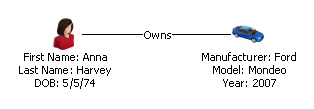ELP relationships in i2 Analyze
Depending on the nature of the data that you want to process in your deployment of i2 Analyze, you might need to shape it to the ELP (entity, link, property) format. Putting data into ELP format enables many of the analytical functions that i2 Analyze provides.
The simplest ELP relationship involves two entities that are connected with a single link. These kinds of relationships are the building blocks for networks that contain groups and chains of entities with any number of links between them.
In i2 Analyze, a simple relationship that involves two entities, a link, and their properties can be visualized like this example:

- For the entity on the left, the data includes the property values "Anna", "Harvey", and "5/5/74".
- Similarly, for the entity on the right, the property values include "Ford", "Mondeo", and "2007".
- The data for the link includes a way of identifying the two entities that it connects.
The remainder of the information in the example comes from definitions in an i2 Analyze schema:
- The default icons for the entities, and the names ("First Name", "Manufacturer") and logical types of their properties, are all defined in an i2 Analyze schema.
- The default label for the link ("Owns") is also defined in an i2 Analyze schema.
In practice, it can be best to make links lightweight and use intermediate entities to model the details of complex associations. Among other things, this approach allows improved modeling of multi-way associations, such as a conference call that has multiple participants. The following diagram shows the difference:

To align your data with an i2 Analyze schema, you must resolve it into the component parts of ELP relationships. If your source is a relational database, it is possible that your tables each correspond to particular kinds of entities, while foreign key relationships form the basis for particular kinds of links. If your source is a delimited text file, it is possible that rows in the file contain the data for one or more entities and links.
